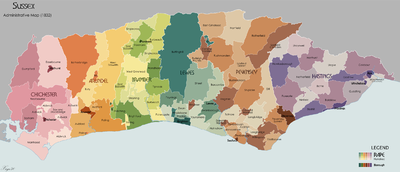Rapes of Sussex
A rape is a division of the county of Sussex and unique to that county. The origin of the rapes is unknown, but they certainly predate the Norman Conquest.[1] Each rape is split into several hundreds.
The rapes of Sussex may derive from the system of fortifications devised by Alfred the Great in the late ninth century to defend against the Vikings,[2] or King Alfred's system may in turn have its roots in an earlier age, I the division of the Kingdom of Sussex. If so, the Sussex Rapes, like the Kentish Lathes, go back to the dawn of English history when their main function would have been to provide food-rents and military manpower to the king.[3]
Etymology
The origin of the name is uncertain. F E Sawyer's derivation from the Saxon rap, a rope, suggesting that ropes were used to mark out territory,[4] though J H Round sagely asked "do those who advance such views realize the size of the districts they have to deal with?"[5] A rope may bound also the precincts of a court for the rape, but any such explanation can be mere speculation.
Norman castleries

At the time of the Norman Conquest there were four rapes: Arundel, Lewes, Pevensey and Hastings. The rape of Arundel consisted of the entire area of Sussex west of the River Adur, corresponding to the boundaries of both the western division of the church in Sussex (the origin of the Archdeaconry of Chichester)[6][7] and the boundaries of the traditional western area of the Sussex dialect.[6] By the time of the Domesday Book, William the Conqueror had created the Rape of Bramber out of parts of the Arundel and Lewes rapes, so that the Adur estuary could be better defended.[7][8][9]
In the Domesday survey, five great Norman lords held the rapes into which Sussex was divided, four of them giving their names to four of the five divisions as they were called in Domesday Book; at the accession of Henry I of England in 1100[10]they were Robert of Bellême in Arundel rape,[11] Robert's nephew William, Count of Mortain in Pevensey,[12] William of Warenne in Lewes,[13] the count of Eu in Hastings and, the only fully trustworthy Sussex lord at the time, Philip de Braose.
Under the Normans each traditional rape was now centred on a castle: Sir Henry Ellis's observation that the rapes "were military districts for the supply of the castles which existed in each" applied to the Anglo-Norman period[14] Each rape had a single sheriff and ran as a strip, north-south, from the border with Surrey or Kent to the English Channel. The castles of Arundel, Bramber and Lewes were sited on positions overlooking the rivers Arun, Adur and Ouse respectively, while those at Chichester, Hastings and Pevensey overlooked the coast.
Between 1250 and 1262, the rape of Chichester was created from the western half of Arundel rape.[7] From this time onwards, Sussex was divided into—from west to east—Chichester, Arundel, Bramber, Lewes, Pevensey and Hastings rapes.
| Name | Castle | Hundreds | Towns and cities |
|---|---|---|---|
| Rape of Chichester | Chichester Castle | Aldwick, Bosham, Box and Stockbridge, Dumpford, Easebourne, Manhood, Westbourne and Singleton | Bognor Regis, Chichester, Midhurst, Selsey |
| Rape of Arundel | Arundel Castle | Avisford, Bury, Poling, Rotherbridge, West Easwrith | Arundel, Littlehampton |
| Rape of Bramber | Bramber Castle | Brightford, Burbeach, East Easwrith, Fishersgate, Patching, Singlecross, Steyning, Tarring, Tipnoak, West Grinstead, Windham and Ewhurst | Crawley, Horsham, Shoreham-by-Sea, Worthing |
| Rape of Lewes | Lewes Castle | Barcombe, Buttinghill, Dean, Fishersgate, Holmstrow, Poynings, Preston, Street, Swanborough, Whalebone, Younsmere | Brighton, Hove, Haywards Heath, Lewes |
| Rape of Pevensey | Pevensey Castle | Alciston, Bishopstone, Burleigh Arches, Danehill Horsted, Dill, East Grinstead, Eastbourne, Flexborough, Hartfield, Longbridge, Loxfield Dorset, Loxfield Pelham, Pevensey Lowey, Ringmer, Rotherfield, Rushmonden, Shiplake, Totnore, Willingdon | East Grinstead, Eastbourne, Uckfield |
| Rape of Hastings | Hastings Castle | Baldstrow, Battle, Bexhill | Battle, Hastings, Rye |
See also
References
- ↑ The origin was still reported as "contested" as late as 1942 (Helen Maud Cam (preface dated 1942), Liberties & communities in medieval England: Collected Studies in Local Administration and Topography, 1944:193).
- ↑ Domesdaybook.net: Rape
- ↑ Domesdaybook.net: Rape
- ↑ F.E. Sawyer "The rapes and their origin", Archaeological Review 1 (1888), p. 54-59.
- ↑ Round, letter in Archaeological Review 1 (1888), p. 229.
- ↑ 6.0 6.1 Hare, Chris (1995). A History of the Sussex People. Worthing: Southern Heritage Books. ISBN 978-0952709701.
- ↑ 7.0 7.1 7.2 "Victoria County History - The rape of Chichester". British History Online. http://www.british-history.ac.uk/report.aspx?compid=41682. Retrieved 31 July 2010.
- ↑ Brandon, Peter (2006). Sussex. Phillimore. ISBN 9780709069980.
- ↑ "Victoria County History - The rape and honour of Lewes". British History Online. http://www.british-history.ac.uk/report.aspx?compid=56907. Retrieved 31 July 2010.
- ↑ Henry's dealings with the lords of the rapes is discussed in Judith A. Green, The Government of England Under Henry I 1989:115.
- ↑ Confiscated by Henry in 1102 and held by the Crown through his reign (Green 1989)
- ↑ Pevensey was confiscated by Henry in 1102 and regranted to Gilbert de l'Aigle (Green 1989).
- ↑ William transferred his allegiance to Henry and remained a stalwart supporter (Green 1989) as Earl of Surrey.
- ↑ Ellis,quoted in Norman John Greville Pounds, The medieval castle in England and Wales: a social and political history 1993:17.